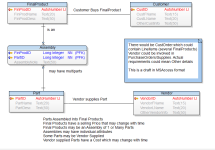mreinsmith
Member
- Local time
- Yesterday, 22:19
- Joined
- Nov 25, 2024
- Messages
- 30
I've been reading about how to use a junction table to do this but I just can't seem to get it straight
I have a list of parts and a list of models
Can someone walk me through the steps of creating the relationships and creating the form for data entry
but most importantly I need to be able to import a csv with that data
If there is a good post with a walk through, maybe point me to that?
Thank You
Matt
I have a list of parts and a list of models
Can someone walk me through the steps of creating the relationships and creating the form for data entry
but most importantly I need to be able to import a csv with that data
If there is a good post with a walk through, maybe point me to that?
Thank You
Matt

